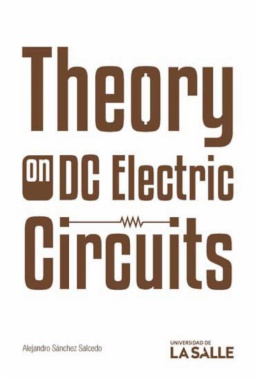This book is intended as a major support for the DC Electric Circuits course from the Electrical Engineering program and the Automation Engineering program at Universidad de La Salle. Its main contribution is to provide the students with a step-by-step explanation and detailed illustrations about the main concepts and analysis techniques of DC electric circuits and their related measurement systems.
- Cover������������
- Title page�����������������
- Copyright page���������������������
- Table of Contents������������������������
- Introduction�������������������
- 1. Electric Risk�����������������������
- 1.1. Common electric risk factors����������������������������������������
- 1.2. Effects of current in human beings����������������������������������������������
- 1.3. Electric impedance of the human body������������������������������������������������
- Exercises����������������
- 2. Significant figures�����������������������������
- 2.1. Rules of significant figures����������������������������������������
- 2.2. Mathematical operations with significant figures������������������������������������������������������������
- Exercises����������������
- 3. System of Units�������������������������
- 3.1. International System of Units�����������������������������������������
- 3.2. Base units����������������������
- 3.3. Derived units�������������������������
- 3.4. Multiples and sub-multiples���������������������������������������
- 3.5. Printing rules��������������������������
- Exercises����������������
- 4. Scientific Notation�����������������������������
- 4.1. Mathematical operations with scientific notation������������������������������������������������������������
- 4.2. Scientific notation and significant figures�������������������������������������������������������
- 4.3. Printing rules��������������������������
- Exercises����������������
- 5. Electrical quantities�������������������������������
- 5.1. Electric charge���������������������������
- 5.2. Electric current����������������������������
- 5.3. Voltage�������������������
- 5.4. Power�����������������
- 5.5. Energy������������������
- Excercises�����������������
- 6. Electric Circuit��������������������������
- 6.1. Circuit elements����������������������������
- 6.2. Electric circuit����������������������������
- 6.3. Circuit concepts����������������������������
- 6.4. Circuit analysis����������������������������
- Exercises����������������
- 7. Ohm’s Law�������������������
- 7.1. Electric resistance�������������������������������
- 7.2. Rated power�����������������������
- Exercises����������������
- 8. Kirchhoff ’s Laws���������������������������
- 8.1. Kirchhoff’s Current Law (KCL)�����������������������������������������
- 8.2. Kirchhoff’s Voltage Law (KVL)�����������������������������������������
- 8.3. Delta-wye and wye-delta transformations���������������������������������������������������
- Exercises����������������
- 9. Methods of Analysis�����������������������������
- 9.1. Nodal analysis��������������������������
- 9.2. Mesh analysis�������������������������
- Exercises����������������
- 10. Operational Amplifier��������������������������������
- 10.1. Ideal OP AMP�������������������������
- 10.2. Inverting amplifier��������������������������������
- 10.3. Non-inverting amplifier������������������������������������
- 10.4. Voltage follower�����������������������������
- 10.5. Summing amplifier������������������������������
- 10.6. Difference amplifier���������������������������������
- 10.7. Cascaded OP AMP circuits�������������������������������������
- 10.8. Non-ideal OP AMP�����������������������������
- Exercises����������������
- 11. Circuit Theorems���������������������������
- 11.1. Linearity theorem������������������������������
- 11.2. Superposition principle������������������������������������
- 11.3. Source transformation����������������������������������
- 11.4. Thévenin’s theorem�������������������������������
- 11.5. Norton’s theorem�����������������������������
- 11.6. Relationship between Thévenin’s and Norton’s theorems������������������������������������������������������������������
- 11.7. Maximum power transfer theorem�������������������������������������������
- Exercises����������������
- 12. Capacitors and Inductors�����������������������������������
- 12.1. Capacitor����������������������
- 12.2. Inductor���������������������
- Exercises����������������
- 13. First-Order Circuits�������������������������������
- 13.1. Solution of first-order differential equation����������������������������������������������������������
- 13.2. Forcing functions: Singularity functions�����������������������������������������������������
- 13.3. First-order circuits���������������������������������
- Exercises����������������
- 14. Second Order Circuits��������������������������������
- 14.1. Solution of second-order differential equation�����������������������������������������������������������
- Excercises�����������������
- 15. Introduction to Measurement Systems in DC Circuits�������������������������������������������������������������
- 15.1. Accuracy���������������������
- 15.2. Precision����������������������
- 15.3. Uncertainty������������������������
- 15.4. Error������������������
- 15.5. Specifications of digital measurement instruments��������������������������������������������������������������
- 15.6. Measurement of DC current��������������������������������������
- 15.7. Measurement of DC voltage��������������������������������������
- 15.8. Measurement of resistance��������������������������������������
- 15.9. Measurement of power���������������������������������
- Exercises����������������
- References�����������������

